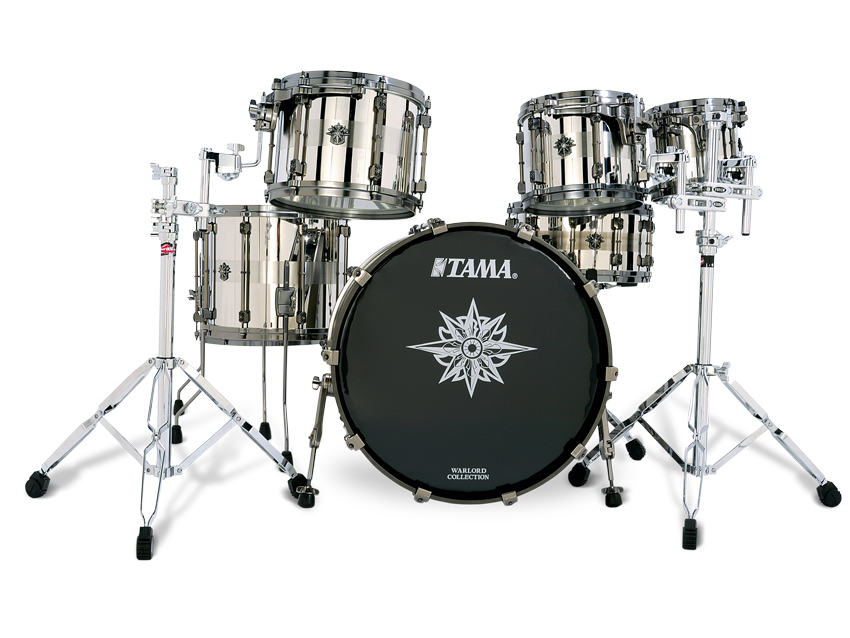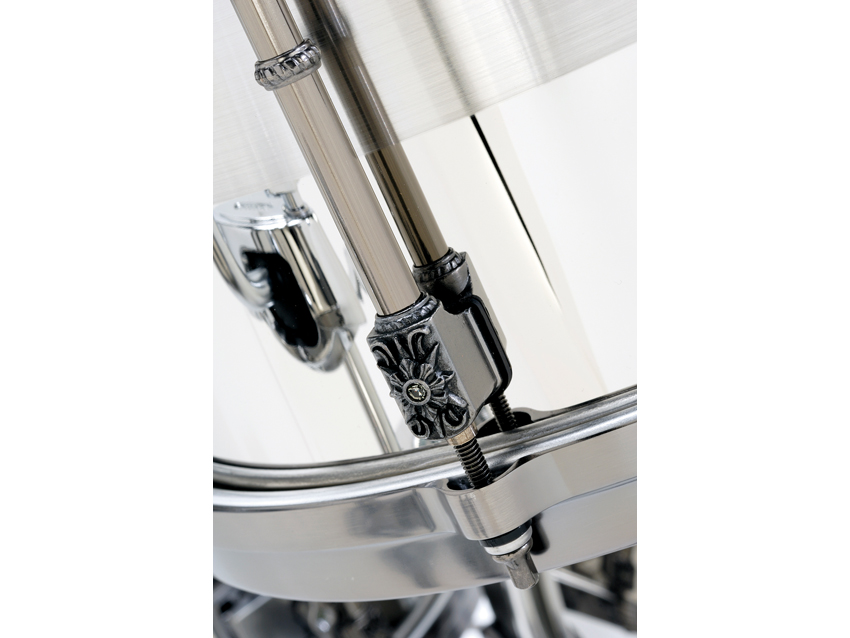MusicRadar Verdict
There is no question that this is an outstanding, if heavy and expensive, set of drums. Stainless steel-shelled kits are a rarity these days, but that´s not to say that there isn´t a market for them. Today´s generation of hard-hitting rockers might ?nd an off-the-shelf steel kit just the ticket. Take the ?amboyant lug design and indulgent jewellery away from this kit and you have a near bespoke, fabulous-sounding, rocking kit.
Pros
- +
Relatively weather proof. No multiple layers of ply and glue affecting tone. Devastating sound.
Cons
- -
Only 50 kits available worldwide. Steel is heavy and expensive.
MusicRadar's got your back

Tama Warlord Spartan Kit

Tama Warlord Spartan Kit

Tama Warlord Spartan Kit

Tama Warlord Spartan Kit
Tama's Warlord Collection began with a quartet of snare drums whose dramatic looks were matched by names verging on the bombastic. Overwrought titles and appearances aside, they were, and continue to be, serious high-end instruments.
In the wake of the success of the snare drums came the recent Warlord Exotix kit, a limited edition set of drums made from bubinga. Now, following in their footsteps, comes the Warlord Spartan, a striking seven-piece stainless steel-shell kit.
Build
Though stainless steel is one of the definitive shell choices for snare drums, whole kits made from it are far from common. Over the years various manufacturers have built stainless steel kits - the best known among them being Ludwig, whose popularity in this field is undoubtedly in no small part thanks to a British endorsee by the name of Bonham - but by and large steel is something of a niche drum kit-making material.
While all drum companies know how to make snare drums out of steel, progressing to an entire kit poses both technical and cost challenges and also guarantees a heavy set of drums at the end. Advocates of steel believe that it's a price worth paying. They cite steel's consistency as the key (there are no multiple layers of ply and glue involved and it is relatively unaffected by weather conditions) in giving drums a purer, more direct tone.
The Warlord Spartan is available in one configuration only, which is the kit pictured - 22"x18" bass drum, 14"x7" snare drum, 8"x7", 10"x8" and 12"x9" toms, and 14"x12" and 16"x14" floor toms. Production is limited to 50 kits worldwide, and out of these a mere three are destined for the UK.
"The bass drum was, quite simply, extraordinary. It gave a murderously deep, powerful response that found every corner of the room it was played in.There were no overtones or shuddering darkness to complicate things, just a taut, saturated blast of bottom end".
The shells are made from SAS304 stainless steel, apparently the most popular material in the metal industry. Each of them is curved into shape from a single sheet of SAS304, and then TIG welded. A clean join is visible inside the shells, but on the outside it is impossible to discern. This is even more impressive when you consider that the shells are effectively one ply thick, so the join would have been obvious on the exterior at the time of welding.
Tama has opted for slight differences in the thickness of the shells across the kit: the bass drum is 1.5mm thick, the 16" floor tom is 1.2mm thick, while all the other drums conform to a thickness of 1mm.
The conventional method for creating bearing edges on metal-shelled drums is, in simplified terms, to bend the top of the shell over, using the resulting fold as the bearing edge. On this kit Tama has developed a more intricate version of this method, which it claims brings huge benefits in sound. Called the Resonant Sound Edge, it uses a double flange - that is, a first fold at the top of the shell and then a second fold underneath back in towards the shell, so in cross section you would be looking at a triangle.
Want all the hottest music and gear news, reviews, deals, features and more, direct to your inbox? Sign up here.
The whole assembly is a sealed unit, as after the second fold the flange then rejoins the shell. The creases of the folds are much sharper than regular metal bearing edges, which can only lead to a cleaner, more precise contact with the head.
The RSE is an impressive piece of engineering; so impressive that we wondered if it were possible to apply a process with such fine tolerances to the top and bottom of each shell with the degree of accuracy found here, or if each RSE unit is made up separately and then attached to the shells by an 'invisible' weld. Tama wouldn't comment, saying that such information was confidential. However, Rhythm magazine's resident drum guru Geoff Nicholls confirmed that such a method is indeed possible and has a historical precedent, often featuring on snare drums made in the 1920s and '30s.
Of course, it's one thing building such a detailed arrangement into a snare drum; what's quite remarkable here is that every drum of this kit has an RSE at either end.
Like all of the Warlord drums and kits that preceded it, the Spartan kit is a striking vision. The mirror-finish drums are studded with full-length tube lugs and crowned with die-cast rims. Swarovski crystals are inserted into the motifs on the tube lugs as well as on the shells themselves. We think the drums are eye-catching enough without the added ostentation of jewels.
We're not entirely convinced that Tama is aiming for a gothic/metal look either; but suspect that the design has more to do with a popular Japanese association with noble warriorhood that we don't really 'get' in the West. Whatever, the drums are an imposing sight as they are but, as the saying goes, sometimes less is more.
Hands On
Evans heads are fitted across the kit - twin-ply clear G2 batters on the toms, a single-ply EQ4 batter on the bass drum and a single-ply G1 coated on the snare drum. The bass drum was, quite simply, extraordinary. It gave a murderously deep, powerful response that found every corner of the room it was played in.
There were no overtones or shuddering darkness to complicate things, just a taut, saturated blast of bottom end. No dampening was used and none was needed, as the drum had a balance of sustain and natural decay that was perfect from the off. Effectively, it arrived already EQ'd.
The snare weighed in with an equally devastating performance, producing a combination of the cutting top end and midrange grunt that is steel's calling card. The fitted die-cast hoops further emphasised its authority.
Unlike the kick and snare, the toms required some tuning, although the results were worth it. At high tunings there was a palpable metallic edge to them, in particular the two smallest toms. The fabled purity of steel was much in evidence and they sounded almost too clean. However, rolling off the tuning brought an immediate and tangible fatness to them. Like the bass drum, they seamlessly blended attacking presence with a walloping, juicy note. All in all, bang on.